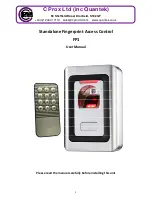
0x00000000
0x08000000
0x08003FFF
0xFFFFFFFF
peripherals
Region0
Region1
No access restrictions
Access restrictions
RAM
Region2
Region3
0xFFF78000
Module Operation
560
SPNU503C – March 2018
Copyright © 2018, Texas Instruments Incorporated
Direct Memory Access Controller (DMA) Module
In a case where a memory protection violation occurs, a flag will be set and an interrupt will be generated,
if interrupts are enabled. The DMA Memory Protection Status Register (
) contains the
status flags for the memory protection mechanism, and the DMA Memory Protection Control Register
(
) contains the interrupt enable bits. Upon detection of the memory protection violation,
the DMA Channel that caused the violation will be stopped and the next available DMA channel will be
serviced.
Illustrates a protection mechanism.
Figure 16-17. Example of Protection Mechanism
16.2.15 Parity Checking
Parity checking is implemented using parity on a per-byte basis for DMA Control Packets in the RAM.
Checking for even or odd parity can be programmed by a 4-bit key located in the system module that
controls the parity configuration on a global basis. This ensures that all modules using parity are acting in
the same manner. The default setup after reset is odd parity.
In addition, parity checking can be enabled and disabled within the module by a 4-bit key. The key is
located in the Parity Control Register (
).
During a read access, regardless if it was read by the DMA state machine or another master (CPU), the
parity is calculated based on the data read from the RAM and compared with the good parity value stored
in the parity bits. If any word fails the parity check, then a parity error interrupt is generated. The address
that generated the error is detected and is captured for host system debugging in the DMA Parity Error
Address Register (
). The address is frozen from being updated until it is read by the bus
master.
















































